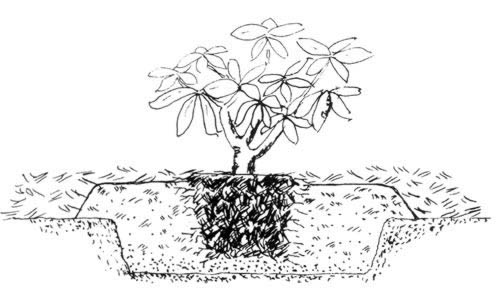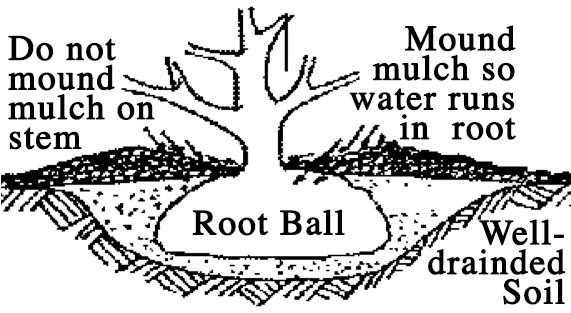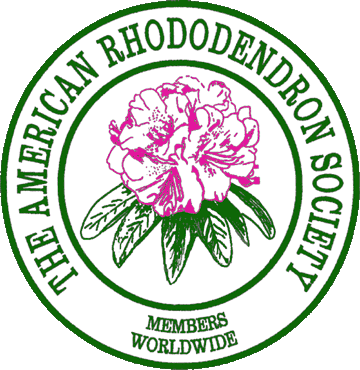|
Rhododendron Culture
10 Steps to Growing Rhododendrons and Azaleas
This article was originally published on Henning's Rhododendrons & Azaleas.
Rhododendrons and azaleas need their cultural requirements met. These requirements basically are:
I. Variety: The rhododendron or azalea must be suitable for the climate where it is planted. Some varieties are too tender for harsh winters, too tender for very hot weather or full sun, too sensitive to droughts or wet conditions. Select the variety for the location. Different varieties grow different heights. Some are tall, over 6', and some are dwarf, barely 12", and many are in between. Unfortunately, most rhododendrons never stop getting taller, but their height is quoted for plants that are 10 years old and by that time most varieties have slowed down their growth considerably. But if you choose plants that are the right size to begin with, they are relatively maintenance free. The American Rhododendron Society website has good charts for rhododendrons and azaleas giving the hardiness and height. Other very useful charts on the ARS website are the Proven Performer Lists that list the favorite rhododendron and azaleas plants for different parts of the US and Canada. The American Rhododendron Society has also applied quality ratings to most rhododendrons and azaleas that are commercially available. The scales run from 1 to 5 for the flower and also for the plant, where 5 is best for the flower and the plant. For example 4/3 has a rating of 4 for the flower and 3 for the plant.
II. Soil Drainage: Rhododendrons and azaleas thrive in moist, well-drained soils high in organic matter. Rhododendrons and azaleas have shallow fine silk-like roots. These roots do not tolerate water-saturated soil conditions but do require moist soils. Poor drainage and wet soils are problems often associated with heavy clay and compacted soil. To test drainage, dig a hole about 10 to 12 inches deep and fill it with water. Then after it drains, fill it with water again and see how long it takes to drain. If the hole drains within an hour you have good drainage. If the water has not drained out of the hole within four hours, the soil is poorly drained and you must correct the drainage problem before planting. Planting in raised beds is the best solution in heavy soils. Raised beds are built on top of the native soil to a depth of 12" to 18" and held in place with timbers or stones. Raised beds may require watering during the summer as they dry out faster. Moist well-drained soil is a must for most varieties. This sounds difficult, but it means to not let the soil dry out completely but don't get it too wet. Thoroughly water if necessary and then let it become almost dry. Most gardeners do this by planting in a well-drained area and mulching to hold the soil moisture in. Then, watering is seldom necessary except during long dry periods. Conditions that provide good drainage usually provide good aeration. However, aeration is sufficiently important that it must be emphasized. The soil must be aerated since the bacteria that make nutrients available to the roots require oxygen.
III. Acidic Soil: Rhododendrons and azaleas prefer acidic soils having a pH between 4.5 to 6.0. Rhododendrons and azaleas will let you know if the pH is not correct. If the leaves turn yellow between green veins then you most likely have a pH problem. If this occurs, a soil test is suggested for exact recommendations on adding a soil amendment to the soil in order to adjust the pH. Materials commonly used to lower soil pH are wettable sulfur or ferrous sulfate. Do not use aluminum sulfate to acidify the soil; it is toxic to rhododendron and azalea roots. Avoid planting azaleas near concrete sidewalks, driveways or foundations that may leach out lime which raises the pH. In rare cases, the pH may be too low. This is equally serious and must be rectified. The recommendation is usually to use dolomitic limestone.

If drainage is fairly good, mound 4 to 6 inches.
For poor drainage or if high pH is a serious problem, use an 8 to 12 inch mound on top of soil. |
IV. Planting: Most rhododendron and azalea plants sold at nurseries and garden centers are sold in containers. These plants have a potentially serious problem when the roots reach the container and start circling inside the pot. They become pot bound or root bound. Before planting, these roots must be cut so they don't continue to grow and start strangling other roots. Many apparently healthy plants die when the roots start strangling each other. To prevent this, it is necessary to remove the plant from the container and examine their roots. If the plants appear pot-bound and have a thick, dense mat of fibrous roots along the surface of the root ball, use a knife to make vertical cuts about every 2 inches and 2 inches or more deep, equally spaced around the sides of the root ball. Then use your hands to gently loosen the roots where cuts were made and pull the roots outward. This process stimulates new root growth and allows water and nutrients to penetrate into the root mass. If the roots are not pot-bound, it is not necessary to slice them with a knife, but it is beneficial to loosen and pull them outward with your hands. When working with roots, make sure the plant is thoroughly watered. Any roots that dry out will die.
V. Fertilizing: When rhododendrons and azaleas are not planted in ideal locations they may develop chlorosis. Chlorosis is yellowing of a leaf between dark green veins. It is caused by malnutrition that can be caused by a wide variety of conditions. They include alkalinity of the soil, potassium deficiency, calcium deficiency, iron deficiency, magnesium deficiency, nitrogen toxicity (usually caused by nitrate fertilizers) or other conditions that damage the roots such as root rot, severe cutting of the roots, root weevils or root death caused by extreme amounts of fertilizer. In any case, a combination of acidification with sulfur and iron supplements such as chelated iron or iron sulfate will usually treat this problem. Holly-tone contains these elements and 4-6-4 fertilizer. It is best applied in the spring prior to blooming to make sure the plant is healthy when forming next year's flower buds. If you missed applying it in the early spring, it can be applied up until mid summer. Rhododendrons do best when left alone in the right conditions. You don't need to use Holly-tone or any fertilizer unless the plant shows signs of malnutrition.
VI. Sun & Shade: Some shade is the best. Some varieties like full sun to bloom but others suffer from too much sun. This is a trial and error thing unless you know the variety and can look it up. More sun stimulates flowering and but may trigger lace bug infestations. Prune off lower branches of shade trees so that you have "high shade" above your rhododendrons. This is ideal for a healthy rhododendron bed.
 |
VII. Mulching: Rhododendrons do best when they have about a 2" to 3" layer of mulch to hold in moisture, prevent weeds, and keep the roots cool. Since most mulches are organic, they need to be topped off periodically, usually about every year or two. Do not make the mulch over 3" thick. Keep the mulch about 3" to 4" back from the trunk/stem of the plants to avoid collar rot, bark split, rodent damage and providing shelter for weevils. Mulching does increase the risk of weevil damage. Do not use peat moss as a mulch. It is a soil amendment to be used when preparing the soil in a bed and can cause severe problems when used as a mulch including dehydrating the soil and preventing moisture from reaching the soil. It also tends to blow around. It is best to mulch with a 2-inch layer of an airy organic material such as wood chips, ground bark, pine needles, pine bark or rotted oak leaves. A year-round organic mulch will also provide natural nutrients and will help keep the soil cool and moist.
VIII. Protection: In choosing a location to plant rhododendrons and azaleas, protection is very important. Protect from winter winds. This is especially true when the ground is frozen. If deer are a problem, protect from deer using deer fencing and deer repellants for plants that were susceptible to deer damage.
IX. Propagation: Plant propagation has two general types: sexual, and asexual or vegetative. Sexual propagation results in seed. It involves two parents and the seedling is a genetic blend of the two parents. Sexual propagation is usually done when the favorable characteristics of two parents are wanted on one plant. This is the field of hybridizing. It sometimes results in markedly improved plants, but a great deal of trial and error is involved. Once a successful hybrid has been created, it must be propagated by asexual methods to make genetically identical plants. Asexual or vegetative propagation is when vegetative tissue is nurtured into a new plant that is genetically identical to the original. Of course, a graft has different roots and top, but the top is genetically identical to the scion. However, the rootstock may cause variation from the original plant, such as dwarfing, disease resistant and tolerance of near alkaline conditions.
X. Cultural Problems: Most problems are cultural. Some tender rhododendron & azalea varieties are not suitable for growing outside green houses. Do not set new plants any deeper than the original soil level. Ensure the root collar is exposed and free of soil and mulch. Rhododendrons and azaleas are subject to collar rot when root flares are buried. When planting in poorly drained soils create raised beds or provide sub-surface drainage. Plant with the root collar exposed. If soil is compacted, prepare planting area by cultivating and incorporating organic matter. Cultivating rhododendrons and azaleas must be avoided. They have shallow roots and the roots will be severely damaged by cultivating. Weed killer from weed & feed products is a serious problem also. Salt from sidewalks in the winter is also a killer of rhododendron and azaleas. Soil near concrete or mortar such as foundations and walks is usually alkaline (not acidic) and a problem. Lawn fertilizer is not good for rhododendrons. Any fertilizer after mid-summer can set rhododendron & azaleas way back. Another problem is the roots of walnut trees. They emit a chemical that is toxic to rhododendrons, azaleas and many other kinds of plants. Return to Top
References
- Bryant, Geoff (1996) Growing Rhododendrons and Azaleas
- Clarke, Jay Harold (1983) Getting Started With Rhododendrons and Azaleas.
- Cox, Kenneth (2008) Plantsman's Guide to Rhododendrons, A,
- Greer, Harold E.(1996) Rhododendron Basics
- Reilley, H. Edward (2004) Success with Rhododendrons and Azaleas
|

Variety
Soil Drainage
Acidic Soil
Planting
Fertilizing
Sun & Shade
Mulching
Protection
Propagation
Cultural Problems
Other Resources
Growing
Rhododendrons
Links
Seeing
Rhododendrons
Links
Acquiring
Rhododendrons
Links
Mail Order
Rhododendrons
Links
Follow us on Facebook!

|
 To return to the Rhododendron Basics Pages click here.
To return to the Rhododendron Basics Pages click here.
 To return to the Rhododendron Basics Pages click here.
To return to the Rhododendron Basics Pages click here.